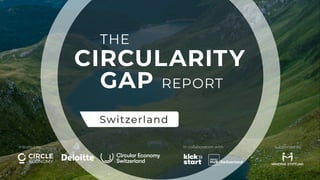Circularity Gap Report Switzerland 2023
- 1. in collaboration with initiated by supported by
- 2. Welcome J├╝rg Stuker juerg@kickstart-innovation.com +41 79 252 67 01 Dr. Maja Wipr├żchtiger wipraechtiger@realcycle.ch +41 44 537 82 81
- 3. 400+ 80+ 200+ 200+ >2B CHF 500+ Startups & intrapreneurship teams Countries engaged Proof of concepts & commercial deals Advisors & experts Raised by Kickstart alumni Partners engaged We help organizations succeed at becoming more sustainable and inventive by accelerating collaboration with well-established startups.
- 6. SwitzerlandŌĆÖs material footprint Source: www.overshootday.org/swiss-overshoot-day-2022-de
- 7. Exceeding planetary boundaries Source: www.pik-potsdam.de/en/news/latest-news/planetary-boundaries-update-freshwater-boundary-exceeds-safe-limits
- 8. Source: Adapted from UNEP (2011). Decoupling natural resource use and environmental impacts from economic growth time Resource use Human well-being Economic Activity (GDP) Environmental Impact Resource use Environmental Impact Doing less with more
- 9. material production use resource extraction (re)manufacturing refurbish reuse recycle refuse losses rethink reduce The Circular Economy Source: Wipr├żchtiger (2022). Environmental Assessment Framework for the Evaluation of Circular Economy Strategies
- 11. Material Flows in Switzerland Source: The Circularity Gap Report Switzerland 2023
- 12. SwitzerlandŌĆÖs Circularity Gap Source: The Circularity Gap Report Switzerland 2023
- 13. How are those insights used to drive action?
- 14. Build a circular built environment Scenarios What do they involve and what are the bene’¼üts they bring? Nurture a circular food system Rethink mobility 1 2 3 Source: Circular Economy Switzerland, circular-economy-switzerland.ch
- 15. Advance circular manufacturing Embrace a circular lifestyle 4 5 Scenarios What do they involve and what are the bene’¼üts they bring? Source: Circular Economy Switzerland, circular-economy-switzerland.ch
- 16. Circularity Roadmap by Overarching objective by 2030: ŌŚÅ Double the Swiss Circularity Metric, thus ŌŚŗ Reduce the Swiss Material Footprint by Ōģō ŌŚŗ Reduce the Swiss Carbon Footprint by ┬Į Source: Circular Economy Switzerland, circular-economy-switzerland.ch Vision by 2050: ŌŚÅ Quadruple the Swiss Circularity Metric by 2050, thus ŌŚŗ Reduce the Swiss Material Footprint per capita by 60% (to maximum 8 tonnes per capita, which is considered within a sustainable and just level by leading research) ŌŚŗ Reduce the Swiss Carbon Footprint by 90% (in line with the SBTŌĆÖs Net-Zero Standard and the 1.5┬░C objective set by the UN-Paris agreement/COP26)
- 17. Collaborative Roadmap Design Five work streams, one for each CGR scenario, designing actions, goals and milestones at the intersectoral, national and cantonal levels. NATIONAL REPORT LAUNCH NOW Call-to-participate in the roadmap design. Roadmap design kickoff. Workshop for the 5 scenarios creating 5 work streams. ADVANCE CIRCULAR MANUFACTURING RETHINK TRANSPORT & MOBILITY BUILD A CIRCULAR BUILT ENVIRONMENT NURTURE A CIRCULAR FOOD SYSTEM EMBRACE A CIRCULAR LIFESTYLE NATIONAL ROADMAP LAUNCH CIRCULARITY ROADMAP FOR SWITZERLAND IMPLEMENTATION ACTIVITIES Call-to-implementation 3-5 workshops for each work stream Source: Circular Economy Switzerland, circular-economy-switzerland.ch
- 18. Roadmap objectives per subject area Vision by 2050: Quadruple Swiss Circularity, Slash Material Footprint by 60%, Slash Carbon Footprint by 90% Goals by 2030: Double Swiss Circularity, Reduce Material Footprint by Ōģō, Reduce Carbon Footprint by ┬Į Source: Circular Economy Switzerland, circular-economy-switzerland.ch Circular Manufacturing Rise Circularity from 6.9% to 7.4%, Reduce Material footprint by 6.4% (from 163 to 153 mio t) Reduce Carbon footprint by 3.7% (from 113 to 109 mio t) Transport & Mobility Rise Circularity from 6.9% to 7.3% Reduce Material footprint by 5.3% (from 163 to 155 mio t) Reduce Carbon footprint by 12.2% (from 113 to 99 mio t) Built Environment Rise Circularity from 6.9% to 8.3% Reduce Material footprint by 4.8% (from 163 to 155 mio t) Reduce Carbon footprint by 12.1% (from 113 to 99 mio t) Circular Food Systems Rise Circularity from 6.9% to 7.6% Reduce Material footprint by 3.1% (from 163 to 158 mio t) Reduce Carbon footprint by 2.4% (from 113 to 111 mio t) Circular Lifestyle Rise Circularity from 6.9% to 7.9% Reduce Material footprint by 15.4% (from 163 to 138 mio t) Reduce Carbon footprint by 15.8% (from 113 to 96 mio t)
- 19. Download your copy of the report https://kickstart-innovation.com/cgr
- 20. initiated by supported by LetŌĆÖs make it happen! in collaboration with




















